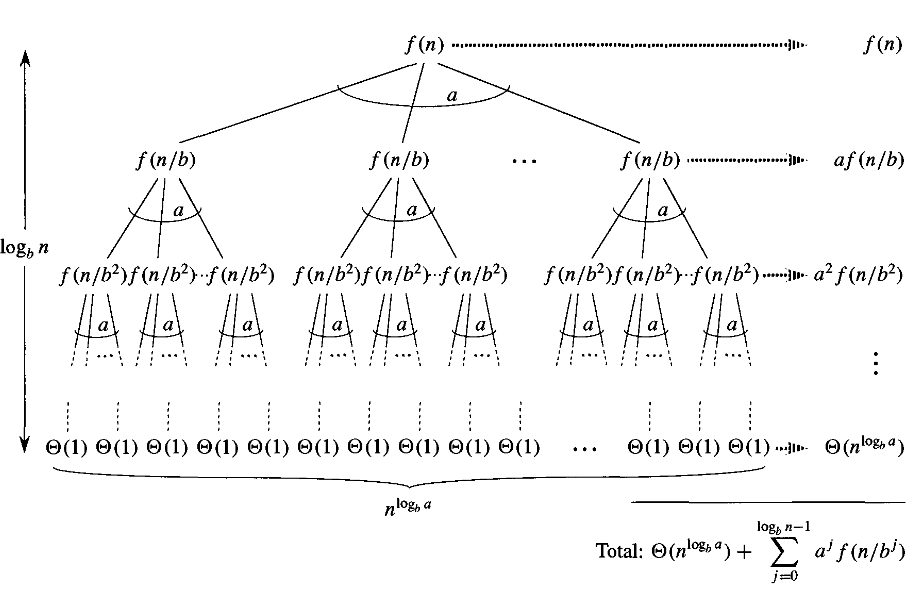I was going the text Introduction to Algorithms by Cormen Et.et al. Where I came across the following statement in the proof of the third case of the Master's Theorem.
(The Statement of Master theorem) Let $a \geqslant 1$ and $b > 1$ be constants, let $f(n)$ be a function, and let $T (n)$ be defined on the nonnegative integers by the recurrence( the recursion divides a problem of size $n$ into $a$ problems of size $n/b$ each and takes $f(n)$ for the divide and combine)
$T(n) = aT(n/b)+ f (n)$ ;
where we interpret $n/b$ to mean either $\lceil b/n \rceil$ or $\lfloor b/n \rfloor$. Then $T(n)$ has the following asymptotic bounds:
If $f(n)=O (n^{log_ba - \epsilon})$$f(n)=O (n^{\log_ba - \epsilon})$ for some constant $\epsilon > 0$, then $T(n)=\Theta (n^{log_ba})$$T(n)=\Theta (n^{\log_ba})$.
If $f(n)=\Theta (n^{log_ba})$$f(n)=\Theta (n^{\log_ba})$, then $T(n)=\Theta (n^{log_ba}lg n)$$T(n)=\Theta (n^{\log_ba}\lg n)$
If $f(n)=\Omega (n^{log_ba + \epsilon})$$f(n)=\Omega (n^{\log_ba + \epsilon})$ for some constant $\epsilon > 0$, and if $af(n/b) \leqslant cf(n)$ for some constant $c < 1$ and all sufficiently large n, then $T(n)=\Theta (f(n))$.
For $n$ as exact powers of $b$ we restrict the domain of T(n) as follows:
$$T(n)= \Theta(1), n=1$$ $$T(n)=aT(n/b)+f(n) ,n=b^i$$
Now in the proof of Master's Theorem with $n$ as exact power of $b$ the expression for $T(n)$ reduces to :
$$T(n)=\Theta(n^{log_ba})+\sum_{j=0}^{log_bn -1} a^jf(n/b^j)$$$$T(n)=\Theta(n^{\log_ba})+\sum_{j=0}^{\log_bn -1} a^jf(n/b^j)$$
Then the authors assume the following,
$$g(n)=\sum_{j=0}^{log_bn -1} a^jf(n/b^j)$$$$g(n)=\sum_{j=0}^{\log_bn -1} a^jf(n/b^j)$$
Then for the proof of the 3rd case of the Master's Theorem the authors prove the following lemma,
$Lemma$ $1$Lemma 1 : If $a.f(n/b)\leqslant c.f(n)$$a\cdot f(n/b)\leqslant c\cdot f(n)$ for some constant $c<1$ and for all $n\geqslant b$ then $g(n)=\Theta(f(n))$
They say that:
under their assumption that $c<1$ and $n \geqslant b$,they have $a.f(n/b)\leqslant c.f(n) \implies f(n/b)\leqslant (c/a).f(n)$$a \cdot f(n/b)\leqslant c \cdot f(n) \implies f(n/b)\leqslant (c/a) \cdot f(n)$
then interatingiterating $j$ times yeildsyields, $f(n/b^j)\leqslant (c/a)^j.f(n)$$f(n/b^j)\leqslant (c/a)^j \cdot f(n)$
I could not quite get the mathematics used behind iterating $j$ times.
Moreover I could not quite get the logic behind the assumption of $n\geqslant b$ for the situation that $n$ should be sufficiently large. (As the third case of the Master's Theorem says).)
The proof of the lemma continues as follows:
$f(n/b^j)\leqslant (c/a)^j.f(n) \iff a^j.f(n/b^j)\leqslant c^j.f(n)$$$f(n/b^j)\leqslant (c/a)^j\cdot f(n) \iff a^j\cdot f(n/b^j)\leqslant c^j\cdot f(n)$$ So, $$g(n)=\sum_{j=0}^{log_bn -1} a^jf(n/b^j)$$$$g(n)=\sum_{j=0}^{\log_bn -1} a^jf(n/b^j)$$ $$\leqslant \sum_{j=0}^{log_bn -1} c^jf(n)$$$$\leqslant \sum_{j=0}^{\log_bn -1} c^jf(n)$$ $$\leqslant f(n)\sum_{j=0}^{\infty} c^j$$ ,$$\leqslant f(n)\sum_{j=0}^{\infty} c^j,$$ as $c<1$ we have an infinite geometric series $$= f(n) (\frac{1}{1-c})$$$$= f(n) \left(\frac{1}{1-c}\right)$$ $$=O(f(n))$$ as $c$ is a constant. (Note that $T(n)=\Omega(f(n))$ from the recursion diagram.)
Then the authors proof the third case of the Masters Theorem for $n$ as exact power of $b$:
$Lemma$ $2$Lemma 2: Let $a \geqslant 1$ and $b>1$, if $f(n)=\Omega (n^{log_ba + \epsilon})$$f(n)=\Omega (n^{\log_ba + \epsilon})$ for some constant $\epsilon > 0$, and if $af(n/b) \leqslant cf(n)$ for some constant $c < 1$ and all sufficiently large n, then $T(n)=\Theta (f(n))$.
So $$T(n) = \Theta(n^{log_ba}) + g(n) = \Theta(n^{log_ba}) + \Theta(f(n)) =\Theta(f(n))$$$$T(n) = \Theta(n^{\log_ba}) + g(n) = \Theta(n^{\log_ba}) + \Theta(f(n)) =\Theta(f(n))$$ as $f(n)=\Omega (n^{log_ba + \epsilon})$$f(n)=\Omega (n^{\log_ba + \epsilon})$
Moreover in the similar proof for the third case of the general master theorem ( notnot assuming $n$ as exact powers of $b$) there again the book assumes that $n\geqslant b+b/(b-1)$ to go with the situation of sufficiently large $n$.
I do not quite understand what the specific value has to do and why such is assumed as sufficiently large $n$
(I did not give the details of the second situation as I feel that it shall be something similar to the first situation but however it can be found here)

